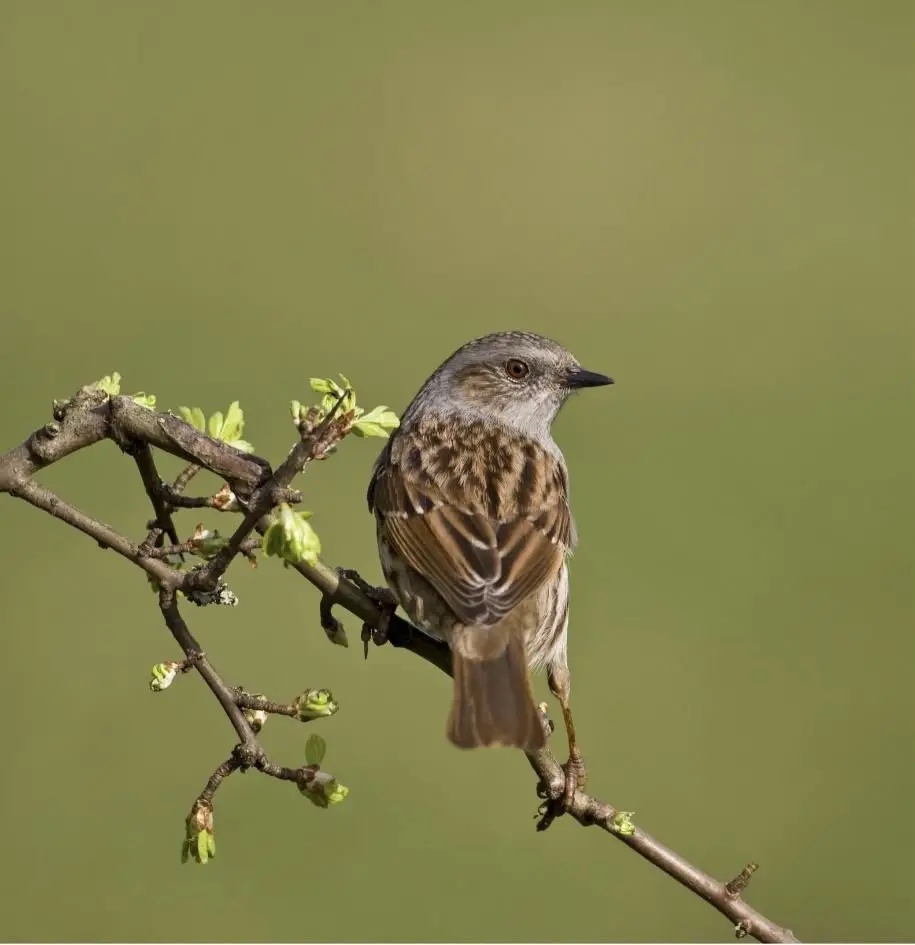The dunnock is a small passerine bird that is found throughout the UK. They are around 10 cm in length and have a slender body with a short tail. Dunnocks are mainly insectivorous, but will also eat seeds and fruit. Dunnocks build their nests in trees or bushes and often use the same nest for several years. The nests are made from grass, moss, and other plant material, and can be quite large for a bird of this size.
Dunnocks usually choose a spot that is sheltered from the wind and offers good visibility. They may also roost in groups, but they typically do not roost with other bird species. Let’s read on to find out more.
What is a dunnock & where do they live?
Dunnocks are about the size of a sparrow and have a streaked brown back and chestnut-coloured head. They are shy birds that live in woodland and gardens. Additionally, these birds are also known for their beautiful singing.
Dunnocks are cavity nesters, meaning they make their nests in holes in trees or buildings. They can be found in Europe and Asia. In Europe, they are found in Great Britain, Ireland, Scandinavia, and the Mediterranean. In Asia, they are found in India and China.
Do They Migrate?
Dunnocks do not migrate, but they are known to move around depending on the season. In winter, they may be found in more open areas such as fields and hedges. In summer, they are more likely to be found in woods and gardens. They may also move to higher elevations in the summer. They do not migrate because they can find food and shelter all year round in their habitat.
Where do dunnocks typically roost?
Dunnocks roost in trees, bushes, and thickets. They are also known to roost in cavities in buildings and walls. They typically roost in dense vegetation or trees. Aside from that, they also roost in nest boxes.
They will often roost in the branches of trees, especially if the tree is located in a wooded area. If there are no trees available, dunnocks will sometimes roost on the ground, typically in a sheltered spot. Dunnocks will sometimes return to their nests at night to roost. This is particularly common if the nest is located in a sheltered location.
By roosting in dense vegetation or trees, they will be safe from predators. Thus, dunnocks do not roost alone. They are known to roost in groups of 2 to 10 birds. Dunnocks may roost with other birds such as tits, sparrows, and finches. They can watch out for each other and take turns sleeping. Roosting in a group provides them with some safety in numbers.
Yes, dunnocks are not particularly territorial birds. In fact, they will gather together in large flocks to rest and socialise in the evening. The location where a dunnock flock chooses to roost can be a good indicator of where that species is most commonly found.
How can you help them find the perfect spot to roost in your yard or garden?
You can help dunnocks find the perfect spot to roost in your yard or garden by providing them with a nest box. Dunnocks are cavity nesters, so they will use a nest box if you provide one. To do this, you can follow these steps:
- The first step is to cut a piece of wood that is 24 inches long and 6 inches wide.
- Drill a hole in the centre that is 3.5 inches in diameter.
- After that, cut out a piece of metal hardware cloth that is 18 inches by 24 inches.
- The fourth step is to attach the metal hardware cloth to the back of the wood with screws or nails.
- Paint the nest box any colour you like. Hang the nest box in a spot where it is sheltered from the wind and make sure the entrance hole is facing south or east.
When you have finished building the nest box, put it in a spot where dunnocks are likely to roost. You may need to wait a while for them to start using it, but eventually, they will find it.
You can also help dunnocks find the perfect spot to roost not only by sheltering them from the wind but predators as well. To do this, you can plant dense vegetation or trees in your yard or garden. This will provide them with a safe place to roost. You can also provide them with a perch, such as a fence post or a tree, to sit on. This will make them feel safe and comfortable. Lastly, if you have cats, then remember to keep them indoors at night!
Lastly, you can put up bird feeders to attract them to your yard or garden. Doing so will help you get to know these beautiful birds better!
Ways to attract these birds to your property and make it their new home
You can also attract these birds to your property by providing them with food and water. You can do this by putting out bird feeders and birdbaths. Additionally, you can plant native plants that produce berries. These birds also love to eat insects, so you can attract them by having a garden that also attracts insects! By providing these birds with what they need, you will be helping them make your property their new home!
Conclusion
Dunnocks typically roost in areas where they can find food and shelter all year round. And if you provide them with a nest box, dense vegetation or trees, and a perch, it will be the perfect spot to roost which will help them feel comfortable and safe. Additionally, you can attract these birds to your property by providing them with food and water. You will be helping them in making your home their new home by doing so!

